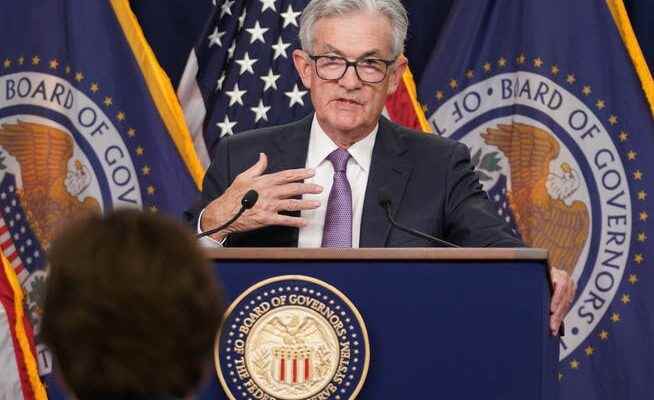The US Federal Reserve raised interest rates by a whopping 75 basis points on Wednesday. The Fed will continue to tighten monetary policy until its “job done” and inflation is brought back to 2 percent, Fed Chairman Powell assured.
Fed Chairman Jerome Powell left no doubt at the press conference that he wants to bring inflation back to 2 percent.
With the third interest rate hike in a row of 75 basis points, the target range for the American key interest rate has risen to 3 to 3.25 percent. In addition, the central bankers are now forecasting that the key interest rate will rise to 4.6 percent in 2023. The rates at which banks can borrow money from the central bank in the short term are now as high as they were last at the beginning of 2008.
Fed Chairman Jerome Powell stressed at his press conference on Wednesday that he was determined to bring inflation back to its 2 percent target. The economy has cooled down significantly compared to 2021; in particular, both consumption and activity on the real estate market have fallen. However, the traces of the previous interest rate increases are not yet being felt on the labor market. Powell emphasized that the number of vacancies is still very high and wages are growing strongly.
The head of the central bank described the current interest rate level as “the lowest level that is restrictive”. Powell acknowledged that price pressures remained high, but tried to calm fears of a wage-price spiral developing by stating that longer-term inflation expectations were still well anchored.
This is crucial for the central bank. Because the more citizens and companies expect inflation to continue, the more they will try to push through higher and higher prices and wages. Such a spiral is difficult to stop.
The dollar soared to a new 20-year high immediately after the interest rate decision, while the euro slipped to a new 20-year low, trading at just $0.9810.
Since the interest rate hike by 75 basis points was already considered quite certain in the run-up to the decision, the observers on Wednesday concentrated on the so-called dot plot, a point diagram. It shows the Fed’s 19 policymakers’ estimates for interest rates at the end of 2022, over the next few years and longer term. The forecasts are represented by dots arranged along a vertical scale.
According to this estimate, the key interest rate is likely to rise to 4.4 percent by the end of the year and to 4.6 percent in the course of 2023, according to the mean estimate in the updated quarterly forecast. This suggests that a fourth straight rate hike of 75 basis points could be on the cards at the next meeting in November, about a week before the midterm elections. Going forward, interest rates are expected to be reduced to 3.9 percent in 2024 and 2.9 percent in 2025.
This looks more likely to be a sustained period of higher interest rates than a quick “slew” to monetary easing early next year. In June, forecasts indicated that the Federal Reserve believed it could orchestrate a soft landing for the previously overheated US economy. The central bankers are now expecting a longer phase of higher interest rates and lower economic growth.
Inflation massively underestimated
The head of the central bank, Jerome Powell, was practically forced to make a resolute rate hike after the central bank massively underestimated the development of inflation since it started to pick up last summer. In August, inflation, which had reached 8.5 percent in July, fell slightly to 8.3 percent. However, the decline was smaller than expected. This downside surprise has been interpreted to mean that inflation has become more stubborn than the central bank had been willing to admit until recently.
Powell and other Fed officials have therefore changed their tone significantly since early summer. The head of the US Federal Reserve recently warned households and companies of “pain” in a widely acclaimed speech in Jackson Hole on August 26th. These would be caused by the “unfortunate costs that fighting inflation” necessarily entails. Powell is currently trying to use clear words and big interest rate hikes to show that he wants to make up for past failures.
A rate hike of less than 75 basis points would have buoyed critics who continue to believe the central bank will struggle to bring inflation back to acceptable levels. There were even speculations that the central bank could raise interest rates by a full percentage point. However, the monetary watchdogs refrained from taking such a big step on Wednesday.
High core inflation points to domestic problems
The main cause for concern at the moment is the development of core inflation, which excludes energy and food prices. In August, this rose by 0.6 percent on a monthly basis and by 6.3 percent on a yearly basis. The economists surveyed had expected rates of 0.3 and 6.0 percent. The fact that core inflation is still picking up shows that prices are not only being driven by the short-term shock of the Russian invasion of Ukraine and the subsequent sanctions and embargoes, but also by domestic factors. In the face of the pandemic, the US government has pursued an unusually generous fiscal policy.
Whether the US has slipped into a recession is controversial. The US economy contracted again in the spring, data from late July showed. Since the economy has already receded in winter, the definition of a so-called technical recession has now been met. However, the situation on the labor market is still very tense. That’s why there’s been talk of a recession that doesn’t feel like one.
Significant slowdown in the economy expected
Wednesday’s rate hike will definitely not be the last according to the latest inflation forecasts. In addition, the central bank is now reducing its balance sheet and selling securities that it acquired during the corona pandemic. This should also increase long-term interest rates.
